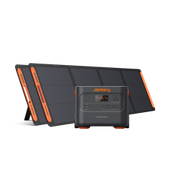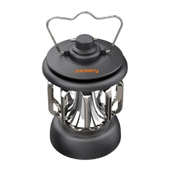A small single-zone mini split draws 15 to 20 amps of current and is the most commonly used heating/cooling appliance in many households. A large multi-zone mini-split system would draw 50 amps or more. To understand how many amps a mini-split uses, it is important to consider its size, efficiency, and type.
Mini-splits are known for their small size and flexibility and are used for zoning and cooling rooms. Since ductless mini-splits are used for heating and cooling purposes, the power consumption may vary whenever you change the settings or temperature. When you cannot always depend upon grid electricity due to frequent blackouts and power outages, you can consider using solar power generators like Jackery Solar Generator that can charge most sizes of mini splits for hours.
Key Takeaways
- Mini-splits come in various sizes and BTUs (British Thermal Units). A mini split of 9000 BTU/hour is ideal for a room of 150 to 400 sq ft.
- In mini splits, the startup wattage is usually two times higher than the running wattage.
- A mini split power meter measures the flow of current and voltage towards the system.
- A small single-zone mini split draws around 15 to 20 amps of current and is the most commonly used heating/cooling appliance in many households.
- A large multi-zone mini-split system would draw 50 amps or more.

How Many Amp Does a Mini Split Use
Mini-splits come in various sizes and BTUs (British Thermal Units). A mini split of 9000 BTU/hour consuming around 750 watts is ideal for a room of 150 to 400 sq ft. This mini split running at 120 volts would draw 6.25 amps of current. Similarly, a 12000 BTU/hour mini-split consuming 1000 watts of power would draw 8.3 amps amperage at 120V.
A mini split of 18000 BTU/hour of 1500 watts would draw 6.25 amps of current when running at 240V, whereas the one with 24000 BTU/hour of 2000 watts would draw 8.3 amps at 240V. The one with 30000 BTU/hour and 2500 watts would draw 10.4 amps at 240V. Similarly, large mini splits with 36000 BTU/hour and 3000 watts would draw 12.5 amps at 240V.
Many factors decide the amperage drawn by a mini-split, including the type, installation, size, operating hours, etc.
Definition of Amps, Volts, Watts, Running Watts
Like other electrical appliances, mini-split air conditioners function on fundamental principles of electricity such as watts, amps, and volts. Understanding these terminologies is important to ensure safety and efficiency while you use mini splits.
Amps (Amperes): Ampere is what measures and indicates how much current your mini split AC is using. Amperage is directly related to power consumption, meaning a greater current flow corresponds to higher power consumption. After you find out the voltage and wattage of your mini-split system, you can calculate the amps using the formula:
Amps = Watts ÷ Volts.
Volts: Voltage is the electrical force that drives the current flow or pushes the electrons through the wire. Proper voltage is required to ensure that the mini-split operates effectively. The voltage of a mini split also depends upon the BTU and size as per the standard circuit system. With adequate voltage, the system functions properly and positively impacts its efficiency.
Volts = Watts ÷ Amps.
Watts: Wattage is the key indicator of an electrical device as it measures the energy consumption rate. In a mini split AC, the wattage denotes how much energy it consumes to cool a space. Generally, higher cooling capacity corresponds to higher wattage. Wattage lets you understand the performance of your mini split and express the relationship between voltage and current using the formula:
Watts = Volts × Amps.
Running Watts: The continuous power consumption of a mini split during normal operation is referred to as its running watts. Knowing the running wattage of an electrical appliance helps to manage energy usage and estimate operational costs. Running wattage can be calculated using the formula:
Running Watts = Volts × Running Amps.
How Many Amps Does a Single, Multi-Zone, Wall Mounted, Floor Standing, Ceiling Cassette, or Mini Split Use?
A single zone mini split of 9000 BTU and 500 to 1500 watts operating at 120V would draw 4.2 to 12.5 amps current. For a multi-zone mini-split, the wattage depends upon the number of zones used at a particular time and the total number of zones in the mini-split.
A wall-mounted mini split of 9000 BTU and 860 to 900 watts operating at 120V would draw 7.1 to 7.5 amps. A floor-mounted mini split of 12000 BTU and 2000 to 3000 operating at 240V would draw around 8.3 to 12.5 amps. A 1-1.5 ton ceiling cassette of 12000 BTU and 1440 watts at 240V would draw 6 amps.
Here's a detailed comparison of the different types of mini splits, the appliance wattage chart, and amp usage:
|
Mini Split Types |
Mini Split Wattage |
Actual Energy Usage (Around ½ of Mini Split) |
Amps ( = Watts / 120 Volts) |
Amps ( = Watts / 240 Volts |
|
Single Zone Mini Split |
500W-1500W |
250W-750W |
4.2-12.5 Amps |
/ |
|
Wall Mounted Mini Split |
860W-900W |
430W-450W |
7.2-7.5 Amps |
/ |
|
Floor Mounted Mini Split |
2000W-3000W |
1000W-1500W |
/ |
8.3-12.5 Amps |
|
Ceiling Cassette Mini Split |
1440W or more |
720W or more |
/ |
6 Amps or more |
How Many Amps Does a Mini Split Draw on a Startup?
On startup, a mini-split operating at a running wattage of 500 watts will have a starting wattage of 1000 watts and draw around 8.3 amps amperage. A surge power is the one that a mini split draws to start the compressor once you turn it on, and this power is higher than the running wattage.
Starting Watts vs Running Watts
The amount of power required to start the mini split system motor is known as the startup wattage. In mini splits, the startup wattage is usually two times higher than the running wattage. This means if the startup wattage of a mini split is 1000W, the running wattage will be 500W.
A household power supply must be strong enough to hold the surge wattage even if it lasts for only a few seconds. As mentioned, the steady power/wattage required for the mini split to operate is its running wattage. Depending upon the BTU, size, and types of mini splits, the power consumption may vary between 500W and 3000W.
For example, if a mini-split runs at 120V and draws 12.5 amps, you can calculate the running watts by using the formula:
Running Watts = Voltage x Running Amps = 120V x 12.5 = 1500W.
Startup Watts = Running Watts x 2 = 1500W x 2 = 3000W.
Note: We multiplied the running watts by 2 because the startup watts are typically 2 to 3 times higher than the running watts.
Startup Amps vs. Running Amps
When the mini split is turned on, the startup amps are higher than the running amps, just like the startup wattage is higher than the running wattage. Running amp is the continuous flow of the mini split's current after the startup phase.
Startup Amps = Running Amps x 2 = 12.5 x 2 = 25A.
How to Calculate Your Mini Split Amps
Calculating how many amps a mini-split uses is crucial to understanding and evaluating your energy requirements. One of the major reasons for knowing amperage consumption is to check its compatibility with power sources like solar generators. Hence, you can learn how to calculate your mini-split amps by utilizing simple yet effective measures.
Method 1: Manufacturer Details: Energy Star Rating
Each electrical appliance comes with a label or detailed user manual mentioning the voltage and wattage information. Using these values, the amperage can be calculated using a simple formula. For example, if a mini-split consumes 1000W of power when plugged into a 120V outlet, then use the formula:
Amps = Watts ÷ Volts = 1000W ÷ 120V = 8.3 amps.
Method 2: Determine The Amps From The Wattage
In case the manufacturer details are unavailable, you can calculate the amps by checking the power source's daily wattage consumption and voltage. For example, if your 500W mini split runs for two hours per day, then it consumes 1000Wh/day. The using the formula:
Amps = Daily Watt Hours ÷ Volts = 1000Wh ÷ 120V = 8.3 amps daily.
Method 3: Mini Split Power Meter
A mini-split power meter measures the power consumption of the mini-split system and helps monitor energy usage. The power meter is installed in between the mini split unit and the power supply. It can also be connected to the wall outlet that powers the mini-split system.
The system measures the flow of current and voltage towards the system, which means the amps drawn by the mini-split and the operating voltage. The real-time data the meter displays include power usage, energy consumption over time, etc. You can also estimate costs based on the local electricity rate.
Tips to Save Your Electricity Bill
Heating and cooling systems consume a higher wattage over time and thereby tend to increase the cost of electricity bills. There are effective ways to run a mini split without compromising your comfort, leading to a reduction in your electricity bill:
- Manage the mini-split run time by consistently using the mini-split instead of turning it on and off to adjust the temperature. You can let a ductless mini split run continuously as it will use less energy and will keep the temperature consistent.
- Optimize the mini-split settings to increase efficiency. Start by picking a comfort level to adjust your temperature settings to keep the desired level of comfort. Next, choose the auto fan setting, which will change the fan speed based on the weather.
- Extreme temperatures can affect the efficiency of mini-splits. If your home is in a region that faces extreme hot or cold temperatures, you should have a secondary heating and cooling source.
- Cleaning your mini-split regularly is another way to maintain its efficiency. You should clean or replace the air filter every 4-5 weeks, ensure proper drainage, and keep the surrounding area clean.
Solar Generators For Mini Split
In areas with abundant sunlight, using solar generators is an eco-friendly way to charge a mini-split, even when there is a power cut or blackout. Even if you decide to go off the grid, solar generators can sufficiently power the mini-split and ensure long working hours.
Jackery Solar Generators are solar power generators that are an eco-friendly alternative to traditional gas generators. The system consists of solar panels and power stations. The solar panels capture direct sunlight through specialized cells and convert it into electrical energy. The electrical energy is then transferred into the power station and converted into AC to charge the mini-split.
Jackery Solar Generator 2000 Plus
The Jackery Solar Generator 2000 Plus has an expandable capacity and can charge essential devices and mini-split during power outages. Whenever you need a mini-split for cooling, the solar generator offers a renewable source of energy. The solar generator supports additional battery packs and is ideal for powering a mini-split, which is connected to a 120V system.

Jackery Explorer 2000 Plus Double Kit
The Jackery Explorer 2000 Plus Double Kit offers a high power output, which is expandable up to 240 volts. With long-lasting reliability, the power station is ideal for charging large unit mini splits. It is ideal for various scenarios, such as off-grid living, and can support weeks of battery backup for home.

|
Jackery Products |
Capacity & Output Watts |
Fan Running Time |
|
Jackery Solar Generator 2000 Plus |
Capacity: 2042.8Wh Rated Output: 3000W |
Single Zone Mini Split (500W): 3.5H Wall Mounted Mini Split (900W): 2H Ceiling Cassette Mini Split (1440W): 1.2H |
|
Jackery Explorer 2000 Plus Double Kit |
Capacity: 4085.6Wh Rated Output: 6000W |
Single Zone Mini Split (500W): 7H Wall Mounted Mini Split (900W): 3.9H Floor Mounted Mini Split (3000W): 1.15H Ceiling Cassette Mini Split (1440W): 2.4H |
FAQs
How many amps does a mini-split system draw?
A single zone mini split of 9000 BTU and 500 to 1500 watts draws around 4.2 to 12.5 amps of current when connected to a 120V outlet.
What size breaker do I need for a 12000 BTU mini split?
A minimum of 20 amp and 30 amp circuit breakers would be required for a 12000 BTU mini split for safe operation.
How many amps does a 12000 BTU Mr Cool mini split use?
A 12000 BTU mini split AC unit requires a 115-volt power supply. This means the 12000 BTU mini split would draw 25 amps.
Do you need 200 amp service for a mini-split?
You will not need 200 amp service if you use a single mini-split. However, you may need to upgrade to a 200 amp service if you are using more than one mini-split unit.
Conclusion
By understanding how many amps a mini-split uses, you can make informed decisions about the right type of power supply and evaluate your mini-split amps. Amperage consumption depends on various factors such as size, units, type, and operation hours. Investing in solar power sources like the Jackery Solar Generators provides a home backup source during power outages and significantly reduces electricity bills.




















































































































Leave a comment